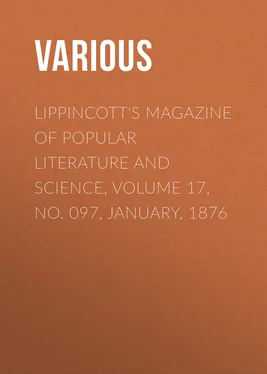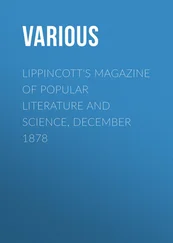Various - Lippincott's Magazine of Popular Literature and Science, Volume 17, No. 097, January, 1876
Здесь есть возможность читать онлайн «Various - Lippincott's Magazine of Popular Literature and Science, Volume 17, No. 097, January, 1876» — ознакомительный отрывок электронной книги совершенно бесплатно, а после прочтения отрывка купить полную версию. В некоторых случаях можно слушать аудио, скачать через торрент в формате fb2 и присутствует краткое содержание. Издательство: Иностранный паблик, Жанр: foreign_antique, periodic, foreign_edu, на английском языке. Описание произведения, (предисловие) а так же отзывы посетителей доступны на портале библиотеки ЛибКат.
- Название:Lippincott's Magazine of Popular Literature and Science, Volume 17, No. 097, January, 1876
- Автор:
- Издательство:Иностранный паблик
- Жанр:
- Год:неизвестен
- ISBN:нет данных
- Рейтинг книги:3 / 5. Голосов: 1
-
Избранное:Добавить в избранное
- Отзывы:
-
Ваша оценка:
- 60
- 1
- 2
- 3
- 4
- 5
Lippincott's Magazine of Popular Literature and Science, Volume 17, No. 097, January, 1876: краткое содержание, описание и аннотация
Предлагаем к чтению аннотацию, описание, краткое содержание или предисловие (зависит от того, что написал сам автор книги «Lippincott's Magazine of Popular Literature and Science, Volume 17, No. 097, January, 1876»). Если вы не нашли необходимую информацию о книге — напишите в комментариях, мы постараемся отыскать её.
Lippincott's Magazine of Popular Literature and Science, Volume 17, No. 097, January, 1876 — читать онлайн ознакомительный отрывок
Ниже представлен текст книги, разбитый по страницам. Система сохранения места последней прочитанной страницы, позволяет с удобством читать онлайн бесплатно книгу «Lippincott's Magazine of Popular Literature and Science, Volume 17, No. 097, January, 1876», без необходимости каждый раз заново искать на чём Вы остановились. Поставьте закладку, и сможете в любой момент перейти на страницу, на которой закончили чтение.
Интервал:
Закладка:
If almighty steam and sail must remain unequal to this task, wondrous indeed are their other potencies. They have contracted the globe like a dried apple, only in a far greater degree. In 1776 three years was the usual allotment of the grand tour. Beginning at London, it extended to Naples and occasionally Madrid. It often left out Vienna, and more frequently Berlin. In the same period you may now put a girdle round the earth ninefold thick. You may, given the means and the faculties, set up business establishments at San Francisco, Yokohama, Shanghai, Canton, Calcutta, Bombay, Alexandria, Rome, Paris, London and New York, and visit each once a quarter. The goods to supply them may travel, however bulky, on the same ship and nearly the same train in point of speed with yourself. Nowhere farther than a few weeks from home in person, nowhere are you more remote verbally than a few hours. The Red Sea opens to your footsteps, as it did to those of Moses; and the lightning that bears your words cleaves the pathway of Alexander and the New World for which he wept.
It is really hard to mention these innovations on the old ways, so vast and so sudden, without degenerating into rhetoric or bombast. The spread-eagle style comes naturally to an epoch that soars on quick new wing above all the others. We have it in all shapes– equally startling and true in figures of arithmetic or figures of speech. Any school-boy can tell you, if you give him the dimensions of the Great Pyramid and state thirty-three thousand pounds one foot high in a minute as the conventional horse-power, how many hours it would take a pony-team picked out of the hundreds of thousands of steam-engines on the two continents to raise it. He will reduce to the same prosaic but eloquent form a number of like problems illustrative of the command obtained over some of the forces of Nature, and their employment in multiplying and economizing manual strength and dexterity and stimulating ingenuity. When we come to contemplate the whole edifice of modern production, it seems to simplify itself into one new motor applied to the old mechanical powers, which may perhaps in turn be condensed into one—the inclined plane. This helps to the impression that the structure is not only sure to be enlarged, as we see it enlarging day by day, but to grow into novel and more striking aspects. Additional motors will probably be discovered, or some we already possess in embryo may be developed into greater availability. These, operating on an ever-growing stock of material, will convince our era that it is but introductory to a more magnificent and not far distant future.
Magnificent the century is justified in styling its work. What matter could do for mind and steam for the hand it has done. But is there any gain in the eye and intellect which perceive, and the hand which fixes, beauty and truth? Is there any addition to the simple lines, as few and rudimental as the mechanical powers, which embody proportion and harmony, or in the fibres of emotion, as scant but as infinite in their range of tone as the strings of the primeval harp, which ask and respond to no motor but the touch of genius? Have we surpassed the old song, the old story, the old picture, the old temple?
Such questions must be answered in the negative. The age, recognizing perforce the inherent capabilities of the race as a constant quantity, contents itself so far with endeavoring to adapt and reproduce, or at most imitate, such manifestations of the artistic sense as it finds excellent in the past. The day for originality may come ere long, and nothing can be lost in striving for it, but a capacity for the beautiful at first hand cannot come without an appreciation of it at second hand. With the number of cultivated minds so vastly increased as compared with any previous period, the greater variety of objects and conditions presented to them, the multiplicity of races to which they belong, and consequently of distinct race-characteristics imbedded in them and brought into play, and the impulse communicated by greater general activity, the expectation is allowably sanguine that the nineteenth century will plant an art as well as an industry of its own. Wealth, culture and peace seldom fail to win this final crown. They are busily gathering together the jewels of the past, endless in diversity of charm. Museum, gallery, library swell as never before. The earth is not mined for iron and coal alone. Statue, vase and gem are disentombed. Pictures are rescued from the grime of years and neglect. All are copied by sun or hand, and sent in more or less elaboration into hall or cottage. In literature our possessions could scarce be more complete, and they are even more universally distributed. The nations compete with each other in adding to this equipment for a new revival, which seems, on the surface, to have more in its favor than had that of the cinque-cento.
UP THE THAMES
THIRD PAPER
Today our movement shall be up the Thames by rail, starting on the south side of the river to reach an objective point on the north bank. So crooked is the stream, and so much more crooked are the different systems of railways, with their competing branches crossing each other and making the most audacious inroads on each other's territory, that the direction in which we are traveling at any given moment, or the station from which we start, is a very poor index to the quarter for which we are bound. The railways, to say nothing of the river, that wanders at its own sweet will, as water commonly does in a country offering it no obstructions, are quite defiant of their geographical names. The Great Western runs north, west and south-east; the South-western strikes south, south-east and north-west; while the Chatham and Dover distributes itself over most of the region south-east of London, closing its circuit by a line along the coast of the Channel that completes a triangle. We can go almost anywhere by any road. It is necessary, however, in this as in other mundane proceedings, to make a selection. We must have a will before we find a way. Let our way, then, be to Waterloo Station on the Southwestern rail.
Half an hour's run lands us at Hampton Court, with a number of fellow-passengers to keep us company if we want them, and in fact whether we want them or not. Those who travel into or out of a city of four millions must lay their account with being ever in a crowd. Our consolation is, that in the city the crowd is so constant and so wholly strange to us as to defeat its effect, and create the feeling of solitude we have so often been told of; while outside of it, at the parks and show-places, the amplitude of space, density and variety of plantations, and multiplicity of carefully designed turns, nooks and retreats, are such that retirement of a more genuine character is within easy reach. The crowd, we know, is about us, but it does not elbow us, and we need hardly see it. The current of humanity, springing from one or a dozen trains or steamboats, dribbles away, soon after leaving its parent source, into a multitude of little divergent channels, like irrigating water, and covers the surface without interference.
It would be a curious statistical inquiry how many visitors Hampton Court has lost since the Cartoons were removed in 1865 to the South Kensington Museum. Actually, of course, the whole number has increased, is increasing, and is not going to be diminished. The query is, How many more there would be now were those eminent bits of pasteboard—slit up for the guidance of piece-work at a Flemish loom, tossed after the weavers had done with them into a lumber-room, then after a century's neglect disinterred by the taste of Rubens and Charles I., brought to England, their poor frayed and faded fragments glued together and made the chief decoration of a royal palace—still in the place assigned them by the munificence and judgment of Charles? For our part—and we may speak for most Americans—when we heard, thought or read of Hampton Court, we thought of the Cartoons. Engravings of them were plenty—much more so than of the palace itself. Numbers of domestic connoisseurs know Raphael principally as the painter of the Cartoons.
Читать дальшеИнтервал:
Закладка:
Похожие книги на «Lippincott's Magazine of Popular Literature and Science, Volume 17, No. 097, January, 1876»
Представляем Вашему вниманию похожие книги на «Lippincott's Magazine of Popular Literature and Science, Volume 17, No. 097, January, 1876» списком для выбора. Мы отобрали схожую по названию и смыслу литературу в надежде предоставить читателям больше вариантов отыскать новые, интересные, ещё непрочитанные произведения.
Обсуждение, отзывы о книге «Lippincott's Magazine of Popular Literature and Science, Volume 17, No. 097, January, 1876» и просто собственные мнения читателей. Оставьте ваши комментарии, напишите, что Вы думаете о произведении, его смысле или главных героях. Укажите что конкретно понравилось, а что нет, и почему Вы так считаете.












